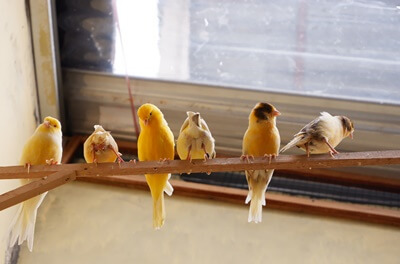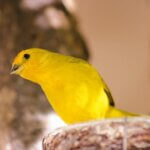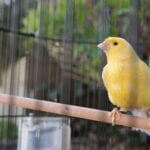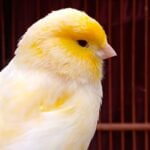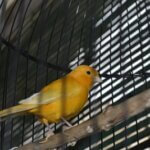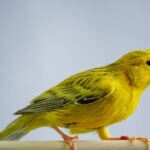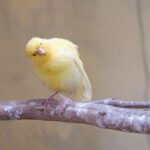If you find your canary shivering, you may be alarmed that it’s sick or convulsing. However, shivering can have benign reasons, so canaries shiver or shake as they preen and express themselves.
Dangerous shivering happens when it’s constant and involuntary, which is usually when the canary is exposed to low temperatures or has caught a viral infection.
What is Shivering in Canaries?
When canaries shiver, their bodies will involuntarily shake rapidly. Depending on the cause of the shivering, it could be full-bodied trembling or tremors in a single body part, like the plumage or the tail.
In certain cases, shivering is shaking, and an owner misinterprets it as shivering. You may think the two descriptions are interchangeable, but there are important differences for birds.
Shaking can be voluntary and a part of a canary’s body language. For example, one canary might shake its wings as a way to spread its feathers out for grooming. Others may shake their lower body, especially around their tail, to show their displeasure.
So, don’t be surprised if your canary “shivers” briefly a few times a day. This is usually the explanation if you’re wondering, “why is my canary shivering when it’s not cold?”
You only need to be concerned when the shaking is constant or intense because this is more likely to be shivering or even a convulsion and needs veterinary intervention.
Here are actions that include (or can be mistaken for) shivering in canaries:
- Static Shivering – This is where it shivers while standing in one spot.
- Mobile Shivering – This is where the shivering doesn’t stop it from moving around the cage.
- Unipedal Quivering – Here, it shakes while standing still and repeatedly shifts its weight from one leg to another.
- Twitching – A form of shivering (occasioned by small muscle contractions) that’s more random than normal shivering.
- Quaking – This is where it flaps its wings as if it wants to fly but doesn’t leave its perch.
What Does It Mean When Canaries Shiver?
Shivering in canaries signifies discomfort or a reaction to environmental issues. Let’s explore each reason for shivering and how you should react:
1/ Cold Temperatures
It’s possible the canary is cold and has begun shivering to warm up. According to the University of Oulu, shivering is the primary thermogenesis method (heat creation) in birds and mammals.
Thermogenesis mainly occurs in skeletal muscle. Unlike in other organisms, the skeletal muscles of birds and mammals are controlled by the central nervous system.
This means they can contract in controlled, rapid, and accurate motions. They can also do so for longer episodes, so your canary may seem to be constantly shivering when it’s feeling cold.
Unfortunately, canaries lack other thermogenic tissues, like brown fat, and rely on skeletal muscle to split their adenosine triphosphate (ATP). This is a cellular compound that is key in the combustion of cellular fuels, which is similarly essential in raising the body’s internal temperature.
Canaries rely more on the contractile activity of their skeletal muscles to generate heat than humans. Thus, they’re likely to shiver at temperatures that may seem normal to mammals.
Constant shivering can overwork the canary’s breast muscles as they contract and relax over and over again, and it can burn lots of energy. This could harm your canary long-term, as it’ll run out of energy and overwork its system to heat up.
So, raise the temperature of your canary’s room when it constantly shivers, as anything below 65-75 degrees Fahrenheit is too cold.
2/ Excessive Heat
Though it may appear counterintuitive, canaries also shiver to remove heat.
According to Physiological Zoology, birds use conduction, convection, and radiation to help them remove warmth if the surrounding temperatures get too hot.
Unfortunately, these approaches become less effective as temperatures increase further. As a result, canaries have developed “gular fluttering.”
The gular in your canary is around its throat. Depending on how strong it flutters, the contractions may appear like shivers localized in the canary’s chest.
Gular fluttering involves rapidly pumping air back and forth in the canary’s respiratory system. In essence, it’s the avian way of panting. It brings in copious amounts of ‘cold’ air from outside, eliminating the ‘hot,’ used air from the bird’s air sacs.
When a canary is distressed enough by high temperatures to flutter its gular, it’ll act lethargic or dazed. After all, it’s using most of its body’s resources to cool down. It may also shake its feathers quickly to move cold air around its body, and these rapid movements may appear like shivering.
If you notice this behavior, move your canary away from direct sunlight, turn on a fan, and offer cool water for drinking and bathing. You do not want to shock your canary by cooling it down too fast, but you should gradually reduce the temperature to avoid heatstroke.
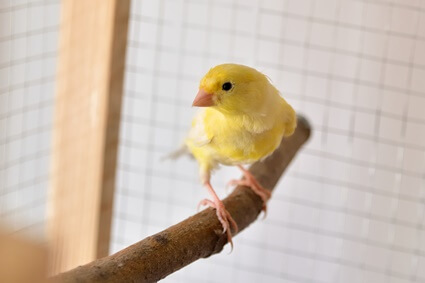
3/ Stress Response
As small prey animals, canaries get stressed by otherwise harmless factors. This may include the voice of a new guest in your house or having their cage moved to a new room.
When overly stressed, a canary may display odd behavior, like head-bobbing, tail-bobbing, and shivering while frozen in place.
The latter usually happens when the ‘threat’ gets too close. It’s a canary’s way of trying to hide when it can’t escape; if it doesn’t move, perhaps the danger won’t notice it.
Check for possible stressors if the surrounding temperatures are within the normal range, and your canary is still shivering. Issues may include:
- Presence of strangers
- A change of hairstyle or hair color on your part.
- The sight of a mirror
- The presence of other pets in the room
- Aggressive cage mate
- Loud or sudden noises
- Flashing lights
4/ Sickness And Disease
Canaries have delicate immune systems and prefer to hide their illnesses, which defends them against predators or other animals that might target them when they are vulnerable.
Unfortunately, this means overt signs of illness appear when they’re too intense for a canary to hide. A common example is excessive shivering, which is when the canary is lethargic but can’t stop trembling.
This could be due to the intense stress your canary is enduring due to illness, or it could be a direct symptom. Shivering can indicate viral infections, like avian flu and canary pox.
A sick canary will exhibit this alongside other symptoms, such as:
- Puffed feathers
- Significant weight loss
- Watery or sore and inflamed eyes
- Constant sneezing and wheezing
- Watery discharge from the beak or nose
- Watery poop
- Reduced singing
- Discolored feathers
- Extreme lethargy
- Loss of appetite
5/ Part of The Grooming Process
Canaries are diligent groomers. A common stage in their preening routine is shaking out feathers, which removes dirt and separates the feathers to provide easier access for their beak to pick out debris.
To an inexperienced owner, this rousing of feathers may appear like quivering. Indeed, a canary may shake its entire body from head to tail to separate its feathers.
This can happen at the beginning of the routine or the end, as the canary works to get all the feathers to fall back into their original positions.
The shivering is likely harmless unless the temperature is low or your canary exhibits other symptoms.

